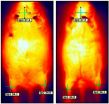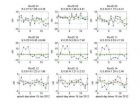(Press-News.org) Modern telecommunications happens because of fast electrons and fast photons. Can it get better? Can Moore's law---the doubling of computing power ever 18 months or so---be sustained? Can the compactness (nm-scale components) of electronics be combined with the speed of photonics? Well, one such hybrid approach is being explored at the Joint Quantum Institute (*), where scientists bring together three marvelous physics research fields: microfluidics, quantum dots, and plasmonics to probe and study optical nanostructures with spatial accuracy as fine as 12 nm.
PLASMONICS
When light strikes a strip of metal an electron wave can be excited in the surface. Is this "surface plasmon" a bit of light or electricity. Well, it's a bit of both. The wavelength of this electromagnetic wave is shorter and the energy density higher than that of the incoming laser light; the plasmon is thus tightly localized light constrained to propagate along the meal surface. The science of "plasmonics" has arisen to capitalize on various imaging, sensing, and processing abilities inherent in plasmons. To start with, though, one needs to know exactly what happens at that laser-excited metallic surface. That light is converted into the plasmonic wave; later the energy can be reconverted into light.
Here's where the JQI experiment comes in. The main result of the work, published February 5 in the journal Nature Communications, is to provide a map showing how the metal strip, in this case a silver wire 4 microns long and 100 nm wide, lights up.
MICROFLUIDICS AND QUANTUM DOTS
The other two chief components of the experiment, in addition to plasmonics, are microfluidics and quantum dots. Microfluidics, a relatively new science all by itself, features the movement of nanoliter volumes of fluids through channels defined on microchips, analogous to the conducting paths strung across microprocessors for carrying electrical currents.
Quantum dots, nanometer-sized semiconductor balls, are tailored to possess a specified set of allowed energy states; in effect the dots are artificial atoms that can be moved around. In the JQI experiment the 10-nm-wide dots (the important cadmium-selenide layer is only 3 nm thick) float in a fluid whose flow can be controlled by varying an applied voltage. The dots are drawn up close to the nanowire as if they were mines next to a submarine.
Indeed the dot is there precisely to excite the wire. The dot is fluorescence machine---in a loose sense a nanoscopic lightbulb. Striking it with green laser light, it quickly re-emits red light (one photon at a time), and it is this radiation which excites waves in the nearby wire, which acts like an antenna. But the interaction is a two-way street; the dot's emissions will vary depending on where along the length of the wire it is; the end of the wire (like any pointy lightning rod on a barn) is where electrical fields are highest and this attracts the most emission from the dot.
A CCD camera captures light coming from the dots and from the wire. The camera qualities, the optical properties of the dot, the careful positioning of the dot, and the shape and purity of the nanowire combine to provide an image of the electric field intensity of the nanowire with 12-nm accuracy. The intensity map shows that the input red light from the quantum dot (wavelength of 620 nm) has effectively been transformed into a plasmonic wavelength of 320 nm.
Chad Ropp is a graduate student working on the project and the lead author on the paper. "Plasmonic maps have been resolved before, but the quantum mechanical interactions with a single emitter have not, and not with this degree of accuracy," said Ropp.
POSSIBLE APPLICATIONS
In an actual device, the quantum dot could be replaced by a bio-particle which could be identified through the nanowire's observed effect on particle's emissions. Or the dot-wire duo could be combined in various configurations as plasmonic equivalents of electronic circuit components. Other uses for this kind of nanowire setup might exploit the high energy density in the plasmonic state to support nonlinear effects. This could enable the nanowire-dot combination to operate as an optical transistor.
INFORMATION:
(*)The Joint Quantum Institute is operated jointly by the National Institute of Standards and Technology in Gaithersburg, MD and the University of Maryland in College Park.
(**) "Nanoscale imaging and spontaneous emission control with a single nano-positioned quantum dot," Chad Ropp, Zachary Cummins, Sanghee Nah, John T. Fourkas, Benjamin Shapiro, Edo Waks, Nature Communications, paper published online 5 February 2013.
Chad Ropp, cropp@umd.edu, 301-405-5010
Press contact at JQI: Phillip F. Schewe, pschewe@umd.edu, 301-405-0989. http://jqi.umd.edu/
Using single quantum dots to probe nanowires
Lighting up plasmonic wires with nanometer accuracy
2013-02-05
ELSE PRESS RELEASES FROM THIS DATE:
Fighting fat with fat: Stem cell discovery identifies potential obesity treatment
2013-02-05
February 5, 2013—Ottawa—Ottawa scientists have discovered a trigger that turns muscle stem cells into brown fat, a form of good fat that could play a critical role in the fight against obesity. The findings from Dr. Michael Rudnicki's lab, based at the Ottawa Hospital Research Institute, were published today in the prestigious journal Cell Metabolism.
"This discovery significantly advances our ability to harness this good fat in the battle against bad fat and all the associated health risks that come with being overweight and obese," says Dr. Rudnicki, a senior scientist ...
Mammogram every 2 years has same benefit as yearly mammogram for older women, UCSF study finds
2013-02-05
Among older women, getting a mammogram every two years was just as beneficial as getting a mammogram annually, and led to significantly fewer false positive results, according to a study led by UC San Francisco.
The national study of more than 140,000 women between the ages of 66 and 89 appears online February 5, 2013, in the Journal of the National Cancer Institute.
"Screening every other year, as opposed to every year, does not increase the probability of late-stage breast cancer in older women," said lead author Dejana Braithwaite, PhD, a UCSF assistant professor ...
Cargo container research to improve buildings' ability to withstand tsunamis
2013-02-05
Anyone who has seen the movie "Impossible" or watched footage from the Japanese tsunami has learned the terror that can strike with little warning. In those cases, when there is no time to flee, there may still be time to reach higher ground, called vertical evacuation.
But as you race to the third floor, how do you know if the building will hold up? Walls of water are not the only danger. Another potentially lethal challenge is water-driven debris - such as 60,000-pound fully loaded cargo containers - transformed into projectiles. Often pulled behind semi-trucks on highways, ...
Olive oil component alleviates intestinal ischemia and reperfusion
2013-02-05
Here's another reason why you should include olive oil in your diet: A new research report published in the Journal of Leukocyte Biology suggests that at least one compound in olive oil significantly reduces intestinal ischemia (restricted blood supply) and the resulting reperfusion injury (tissue damage caused when blood supply returns). The compound, called "oleuropein aglycone," is the most prominent polyphenol found in olive oil and could become a novel therapeutic target aimed at treating intestinal ischemia and reperfusion injury in humans. Ultimately, this research ...
Flexible classroom design saves money, improves flexibility, accessibility of instruction
2013-02-05
Researchers at North Carolina State University have developed a classroom design that gives instructors increased flexibility in how to teach their courses and improves accessibility for students, while slashing administrative costs.
Specifically, the new classrooms take advantage of the fact that students are bringing their own technology – such as laptops – to class. The classrooms also include mobile infrastructure, where whiteboards, desks and tables can be reconfigured according to the needs of students and instructors.
"These classrooms work really well in terms ...
Chest pain prior to a heart attack can protect the heart
2013-02-05
MINNEAPOLIS, MN – Feb. 5, 2013 – Patients who experience chest pain in the 24 hours preceding a heart attack, also called preinfarction angina, have smaller heart attacks and improved cardiac function in the contemporary cardiac stenting era, researchers found in a study published Jan. 22 in Circulation: Cardiovascular Interventions.
"Even before we began treating heart attack patients with angioplasty and stenting, physicians recognized that patients with chest pain prior to their heart attack seem to have better outcomes," says the study's senior author, Jay H. Traverse, ...
Precise Point Positioning and real-time positioning accuracy for COMPASS satellite navigation
2013-02-05
COMPASS uses the Geostationary Earth Orbit (GEO) and Inclined Geosynchronous Satellite Orbit (IGSO) satellites, which are more suitable for regional services. Its constellation is composed of 14 satellites, including 5 GEO, 5 IGSO satellites and 4 Medium Earth Orbit (MEO) satellites. As of 2012, 13 satellites have been launched. Except for G2 (unusable) and M1 (testing only), the remaining 11 satellites, including 4GEO+5IGSO+2MEO, have successfully transmitted signals and broadcasted navigational messages, to prepare for full operation starting in 2013.
Positioning accuracy ...
The zebrafish revealed a central regulator for the development of the brain histamine system
2013-02-05
Research has shown that mutations in the psen1 gene are common in the familial forms of Alzheimer's disease, and the Presenilin-1 protein that the gene encodes is known to be involved in the cleavage of the amyloid precursor protein. In Alzheimer's disease the amyloid precursor protein is not cleaved the normal way, and the protein accumulates in the brain damaging neuronal tracts and neurons. It is still unknown if the psen1 gene is involved in the etiology of Alzheimer's disease via another mechanism.
Professor Pertti Panula's research team at the University of Helsinki ...
Growth arrest in prostate cancer
2013-02-05
A previously poorly investigated signalling pathway is crucial for the growth and proliferation of prostate cancer cells. An international research team discovered this when studying the enzyme "soluble adenylyl cyclase" that produces the second messenger molecule cAMP. When the scientists inhibited the enzyme, the cancer cell proliferation was suppressed. The team led by Dr. Yury Ladilov from the Department of Clinical Pharmacology at the Ruhr-Universität Bochum reported together with colleagues from the Department of Urology at the RUB and the Cornell University in New ...
A review of the rapidly evolving field of topological insulator hybrid structures
2013-02-05
Topological insulators are novel materials that are insulating in the bulk but have surface states that are conducting. These surface states are topologically protected and possess several intriguing properties with the promise of potential applications. As a result, topological insulators have attracted many theoretical and experimental studies in the last few years. More recently, the potential of interfacing topological insulators with other materials with quantum states to make hybrid structures has been recognized and a slew of new studies are underway. Professor Jian ...
LAST 30 PRESS RELEASES:
Numbers in our sights affect how we perceive space
SIMJ announces global collaborative book project in commemoration of its 75th anniversary
Air pollution exposure and birth weight
Obstructive sleep apnea risk and mental health conditions among older adults
How talking slows eye movements behind the wheel
The Ceramic Society of Japan’s Oxoate Ceramics Research Association launches new international book project
Heart-brain connection: international study reveals the role of the vagus nerve in keeping the heart young
Researchers identify Rb1 as a predictive biomarker for a new therapeutic strategy in some breast cancers
Survey reveals ethical gaps slowing AI adoption in pediatric surgery
Stimulant ADHD medications work differently than thought
AI overestimates how smart people are, according to HSE economists
HSE researchers create genome-wide map of quadruplexes
Scientists boost cell "powerhouses" to burn more calories
Automatic label checking: The missing step in making reliable medical AI
Low daily alcohol intake linked to 50% heightened mouth cancer risk in India
American Meteorological Society announces Rick Spinrad as 2026 President-Elect
Biomass-based carbon capture spotlighted in newly released global climate webinar recording
Illuminating invisible nano pollutants: advanced bioimaging tracks the full journey of emerging nanoscale contaminants in living systems
How does age affect recovery from spinal cord injury?
Novel AI tool offers prognosis for patients with head and neck cancer
Fathers’ microplastic exposure tied to their children’s metabolic problems
Research validates laboratory model for studying high-grade serous ovarian cancer
SIR 2026 delivers transformative breakthroughs in minimally invasive medicine to improve patient care
Stem Cell Reports most downloaded papers of 2025 highlight the breadth and impact of stem cell research
Oxford-led study estimates NHS spends around 3% of its primary and secondary care budget on the health impacts of heat and cold in England
A researcher’s long quest leads to a smart composite breakthrough
Urban wild bees act as “microbial sensors” of city health.
New study finds where you live affects recovery after a hip fracture
Forecasting the impact of fully automated vehicle adoption on US road traffic injuries
Alcohol-related hospitalizations from 2016 to 2022
[Press-News.org] Using single quantum dots to probe nanowiresLighting up plasmonic wires with nanometer accuracy



